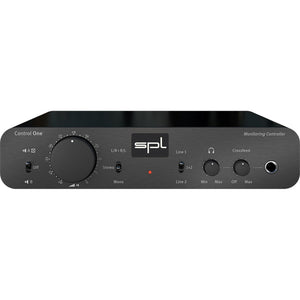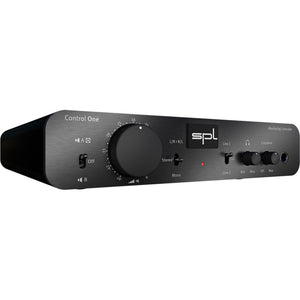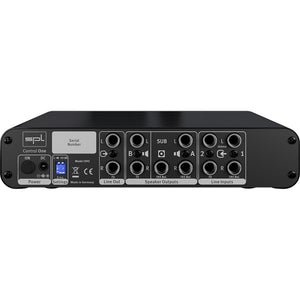Your Cart is Empty
Order Online or Choose Click & Collect - FREE Shipping on most orders over $100
Menu
-
- Computer Audio
- Studio Gear
- Instruments
- Monitoring
- DJ
- Live Sound
- Video
- SALE
-
- News
- New Arrivals
- Sign Up to our Newsletter
- About Us
- Contact Us
- CLEARANCE
- OPEN BOX
- Brands
- Cable Clearance
- SUPER SALE
- 1300 13 0202
- Login

Order Online or Choose Click & Collect - FREE Shipping on most orders over $100
$1,099.00$1,292.94
SPL-CONTROLONE
SPL Control One Monitor Controller
Speaker & Subwoofer
You can listen to your production via two switchable pairs of speakers. A subwoofer is also switched on and off with speaker pair A.
In the middle position of the switch, the speakers are switched off, which is convenient because you don’t have to turn the volume control back.
Two Stereo Inputs
Two analog stereo inputs can be connected to the Control One for sources such as a DA converter, CD player, mixing console, mic preamp, synthesizer or analog tape machine/tape deck, which can also be listened to mixed together (1+2).
Line Out
The selected input signal is output unchanged at the Line Out. This allows the Control One to be looped between devices without “losing” an output.
If, for example, several people are to listen in via headphones, a headphone amplifier can simply be connected to the Line Out. You can also record the signal analog or send it to a mixer for further processing.
Three Monitoring Modes
are offered by the Control One. In the middle is the default setting “Stereo”. To check the mono compatibility set the switch to “Mono”. The special feature is the channel swap function:
L/R > R/L
reverses the stereo image. L/R becomes R/L. This is especially important and extremely time-saving when you are searching your sound library for samples in video dubbing that should match a scene with direction of movement.
If the direction is not correct, you usually have to load the sample into the DAW to switch channels before you can hear if the sample fits.
With the L/R > R/L function this is no longer necessary. You can now simply swap the direction of movement while prelistening samples in the library.
The Headphone Power Amp
Poor sound over headphones?
Not enough juice?
Not here. Control One delivers a rich headphone sound and it can get really loud.
The output stage of the headphone amplifier is designed as a push-pull amplifier in class AB mode. The bipolar transistors share the amplification of the positive and negative half-waves, which produces a higher gain and a higher output voltage than in Class A operation, where only one transistor amplifies both half-waves.
The output stage transistors are thermally coupled and thus run particularly coherently, which contributes to a consistent and stable sound image.
The power supply has a buffer circuit with low source resistance, ensuring generous current reserves even when driving low-impedance headphones.
The Revolution
in the headphone amplifier is the Phonitor Matrix, with adjustable crossfeed, thanks to which you can create mixes with headphones that sound the same on speakers.
The Phonitor Matrix in its largest expansion stage has three parameters: Crossfeed, Speaker Angle and Center Level.
In the Control One, the center level is preset to -1 dB and the speaker angle to 30°. These are the most commonly used values. The crossfeed function determines the so-called interaural level difference. The intensity of the crossfeed is fully variable. At the beginning of the control path the crossfeed circuit is not in the audio path. Dialing the control in switches on the crossfeed circuit via relay (hysteresis circuit). The audio signal therefore does not pass through the crossfeed stage if this is not desired.
Power Supply
Good sound always starts with the power supply. This is where you lay the foundation for the performance of the entire device.
Although we “only” supply a 12 V plug-in power supply unit, the secondary power supply inside generates a voltage level of +/-17 Volts for the analog audio sections with which professional levels of up to +22.5 dB can be achieved!
An elaborate low-drop operating voltage regulation provides more “juice” and regulates cleanly even when the maximum operation voltage is reached.
The Control One delivers full power when used with the included 1.5 A power supply. Only use the 12 V plug-in power supply unit within the scope of delivery. The ON-switch puts the Control One into operation.
Type: Monitor Controllers





